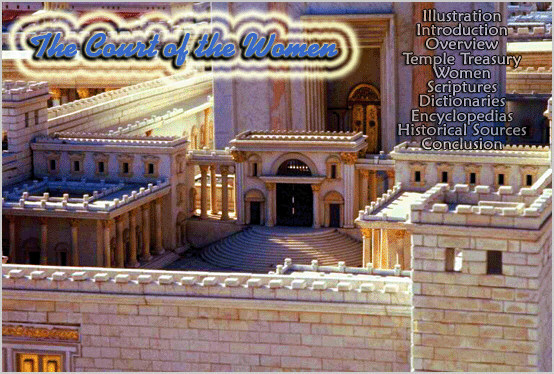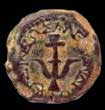The Court of the Women in the Temple
The Temple Treasury

Charitable Donations at the Women's Court

The inner area of
the Temple contained three courts. The easternmost court was the Court of the
Women, and it contained the Temple treasury where people donated their money (Mk
12:41-44). Three gates led into this court, one on the north, one on the south,
and a third on the east. This third gate on the east side is almost certainly
the "Beautiful Gate" that was mention in Acts 3. A fourth gate, which was much
larger and ornate led from the Court of the Women west into the Court of Israel
(women could proceed no further), which was elevated 15 steps higher than the
Court of Women.
The 13
Contribution Chests (Trumpets)
According to the
Mishnah (Middoth 2,5) the Women's Court was was just over 200 feet square
between bounding lines. Each court on the outside was 60 feet square. The
colonnade ran around the court, and within it, against the wall, the thirteen
chests, or 'trumpets,' for charitable contributions were placed.
These thirteen
chests were narrow at the mouth and wide at the bottom, shaped like trumpets.
There were actually eleven treasure chests of the Temple for the voluntary
offerings of money, and then also two at the Gate of Susan, for the half-shekel
tax.
Their specific
objects were carefully marked on them. Nine were for the receipt of what was
legally due by worshippers; the other four for strictly voluntary gifts.
According to
tradition Edersheim says:
Trumpets 1 and 2
were appropriated to the half-shekel Temple-tribute of the current and of the
past year.
Into Trumpet 3
those women who had to bring turtledoves for a burnt and a sin offering dropped
their equivalent in money, which was daily taken out and a corresponding number
of turtledoves offered. This not only saved the labour of so many separate
sacrifices, but spared the modesty of those who might not wish to have the
occasion or the circumstances of their offering to be publicly known. Into this
trumpet Mary the mother of Jesus must have dropped the value of her offering
(Luke 2:22,24) when the aged Simeon took the infant Saviour 'in his arms, and
blessed God.'
Trumpet 4 similarly
received the value of the offerings of young pigeons.
In Trumpet 5
contributions for the wood used in the Temple;
in Trumpet 6 for
the incense, and
in Trumpet 7 for
the golden vessels for the ministry were deposited. If a man had put aside a
certain sum for a sin-offering, and any money was left over after its purchase,
it was cast into Trumpet VIII. Similarly,
Trumpets 9, 10, 11,
12, and 13 were destined for what was left over from trespass-offerings,
offerings of birds, the offering of the Nazarite, of the cleansed leper, and
voluntary offerings. In all probability this space where the thirteen Trumpets
were placed was the 'treasury,' where Jesus taught on that memorable Feast of
Tabernacles (John 7 and 8; see specially 8:20). We can also understand how, from
the peculiar and known destination of each of these thirteen 'trumpets,' the
Lord could distinguish the contributions of the rich who cast in 'of their
abundance' from that of the poor widow who of her 'penury' had given 'all the
living' that she had (Mark 12:41; Luke 21:1). But there was also a special
treasury-chamber, into which at certain times they carried the contents of the
thirteen chests; and, besides, what was called 'a chamber of the silent,' where
devout persons secretly deposited money, afterwards secretly employed for
educating children of the pious poor.
It is probably in
ironical allusion to the form and name of these treasure-chests that the Lord,
making use of the word 'trumpet,' describes the conduct of those who, in their
almsgiving, sought glory from men as 'sounding a trumpet' before them (Matthew
6:2)--that is, carrying before them, as it were, in full display one of these
trumpet-shaped alms-boxes (literally called in the Talmud, 'trumpets'), and, as
it were, sounding it.
The allusion is all
the more pointed, when we bear in mind that each of these trumpets had a mark to
tell its special object. It seems strange that this interpretation should not
have occurred to any of the commentators, who have always found the allusion
such a crux interpretum. An article in the Bible Educator has since
substantially adopted this view, adding that trumpets were blown when the alms
were collected. But for the latter statement there is no historical authority
whatever, and it would contravene the religious spirit of the times.
Read
More about The Jerusalem Temple.
--------------------------
Some
Commentary Notes:
Edersheim - The
musical instruments used by the Levites were deposited in two rooms under the
Court of the Israelites, to which the access was from the Court of the Women. Of
course the western colonnade of this court was open. Thence fifteen easy steps
led through the so-called Gate of Nicanor into the Court of Israel. On these
steps the Levites were wont on the Feast of Tabernacles to sing the fifteen
'Psalms of Degrees,' or ascent (Psalms 120 to 134), whence some have derived
their name. Here, or, rather, in the Gate of Nicanor, all that was ordered to be
done 'before the Lord' took place. There the cleansed leper and the women coming
for purification presented themselves to the priests, and there also the 'water
of jealousy' was given to the suspected wife.
Read More
Edersheim - Court of the Women. The Court of the Women obtained its
name, not from its appropriation to the exclusive use of women, but because they
were not allowed to proceed farther, except for sacrificial purposes. Indeed,
this was probably the common place for worship, the females occupying, according
to Jewish tradition, only a raised gallery along three sides of the court. This
court covered a space upwards of 200 feet square. All around ran a simple
colonnade, and within it, against the wall, the thirteen chests, or 'trumpets,'
for charitable contributions were placed.

The Women's Court in the
Temple in Jerusalem

Mark 12:41-44 "Now Jesus sat opposite the treasury and saw how the people
put money into the treasury. And many who were rich put in much. Then one
poor widow came and threw in two mites, which make a quadrans. So He called
His disciples to Himself and said to them, "Assuredly, I say to you that
this poor widow has put in more than all those who have given to the
treasury; for they all put in out of their abundance, but she out of her
poverty put in all that she had, her whole livelihood."
The
Jerusalem Temple
 If you were to approach the Temple in
Jerusalem in the first century A.D. you would pass through the eastern gate
where Jesus made His triumphal entry. Then you would come to the Court of
the Gentiles which was a large court paved with stones of various colors. It
was open to all comers including the cattle-dealers and the money-changers
who desecrated the Temple. This court was also called the Outer Court, the
Lower Court, and the rabbi�s usually called it "the Mountain of the Lord�s
House." All around the Temple proper was a 9 foot high terrace with stairs
which was higher than the Court of the Gentiles. It was surrounded by a 5
foot high wall which was designed to keep out the gentiles. There was also
pillars in the wall at various distances (the Soreg) with inscriptions in
Latin, Greek, and Hebrew, warning all gentiles to come no further under
penalty of death.
If you were to approach the Temple in
Jerusalem in the first century A.D. you would pass through the eastern gate
where Jesus made His triumphal entry. Then you would come to the Court of
the Gentiles which was a large court paved with stones of various colors. It
was open to all comers including the cattle-dealers and the money-changers
who desecrated the Temple. This court was also called the Outer Court, the
Lower Court, and the rabbi�s usually called it "the Mountain of the Lord�s
House." All around the Temple proper was a 9 foot high terrace with stairs
which was higher than the Court of the Gentiles. It was surrounded by a 5
foot high wall which was designed to keep out the gentiles. There was also
pillars in the wall at various distances (the Soreg) with inscriptions in
Latin, Greek, and Hebrew, warning all gentiles to come no further under
penalty of death.
Going beyond the Court of the Gentiles and at the top of the terrace there
was a platform for about 15 feet and then there was another wall. On the
east side stood the magnificent 60 foot wide "Gate Beautiful" mentioned in
Acts 3:2,10. It was also referred to as the "Gate Susan" because it
contained a beautifully sculptured relief of the city of Susa. During the
time of the morning and evening sacrifices this great entrance was the place
of public worship.
Entering through the Susan Gate you would come to a large court called "the
Court of the Women" not because there were only women there but because
women could not go beyond it. There were smaller courts with columns in the
four corners of the court.
According to the Mishnah (Middoth 2,5) the Women's Court was was just over
200 feet square between bounding lines. Each court on the outside was 60
feet square.
In front of these columns were the eleven treasure chests of the Temple for
the voluntary offerings of money, and there were also two at the Gate of
Susan, for the half-shekel tax. Jesus was sitting �opposite the treasury'
when he saw the widow put into one of the containers the two copper coins
which were all that she had (Mark 12:41-44; Lk 21:1-2).
It was near these treasure chests that the man healed of his blindness came
up to Jesus in John 8:20 and worshipped Him.
Continuing eastward there was a magnificent circular staircase and the
Nicanor Gate. Entering through the gate there was a narrow hall filled with
beautiful cloistered columns called "Court of the Israelites" and it was
also through a wall and up a flight of stairs. The Court of the Israelites
surrounded the "Court of the Priests" which was where the altar of sacrifice
was. The women could only glance over a balcony from the Court of the Women
to see the ceremonies inside the Inner Court (According to Middoth).
Illustration
Introduction
Overview
Chel
Beautiful Gate
Nicanor Gate
Circular Steps
Levite Choirs
Oil of Yah Court
Nazarite Court
Leper's Chamber Court
Woodshed Court
Colonnades
Balconies
The Temple Treasury
Women
Scriptures
Dictionaries
Encyclopedias
Historical Sources
Heart Message
An Old
Woman - A Heart Message

Related Content